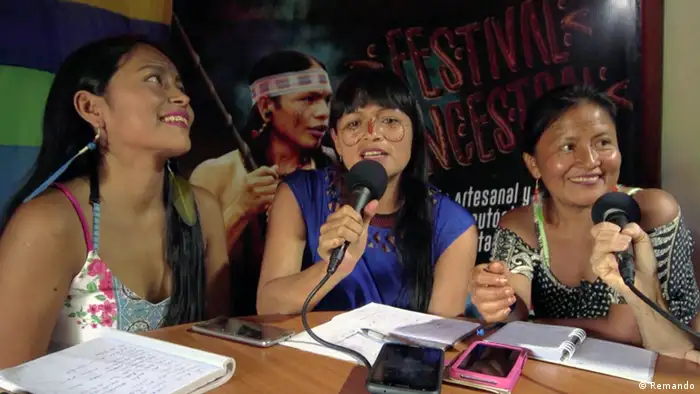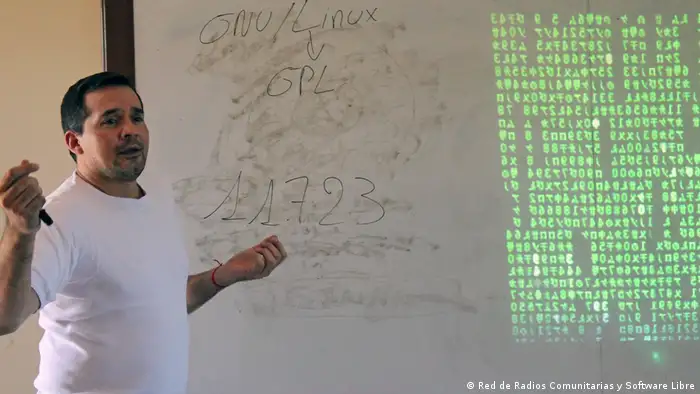DW AKADEMIE
Local and community media in a pandemic: Technological responses and challenges in Latin America and Africa
The pandemic has weakened local and community media right when their reporting was most needed. However, many have turned this challenge into an opportunity. DW Akademie draws some of the lessons learned by our partners.

From the Ecuadorian Amazon, a team of women produces the podcast Remando to inform local communities
On March 11, 2020, the World Health Organization (WHO) designated COVID-19 as a global pandemic. From that day on, almost the entire planet locked itself indoors to reduce the number of infections and deaths. Meanwhile, despite scientific evidence, denialist tendencies gained momentum, encouraged by some governments as well as a few media outlets and social network users.
The rise of dis- and misinformation, which often spread almost as fast as the virus, made the role of media to alert and inform responsibly and reliably particularly relevant. Many local and community media outlets, often with scarce human and financial resources to respond to the crisis, had to interrupt their broadcasts during the first weeks of the pandemic. They lost the ability to keep their communities informed, many of which rely on that single information source to stay up to date.
This was the case for Radio Sayaxché in northern Guatemala, near the Mexican border, as well as the radio program of the Unión de Mujeres Aymaras del Abya Yala (UMA), which broadcasts in their native language to very remote villages around the city of Puno in southern Peru. The Amazonian women who run the "Remando" podcast, who belong to the Confederation of Indigenous Nationalities of the Ecuadorian Amazon, also had to suspend their program.
"It was paralyzed for about two months because almost the entire community where the radio studio is located was infected. We looked for a way to work through the internet, but, although we live in urban areas, there is no electricity or phone network," said Mariana Canelos, who produces Remando together with Rupay Sisa and Jiyun Ukunkar.
Dozens of radio stations experienced similar situations, not only in Latin America but also in Asia and Africa. Levi Katire, coordinator of Omaheke Radio in Namibia, was one of those who was stopped from broadcasting.
"Since we could not communicate as usual, the community was very upset. They called and said: 'What is happening with the station?'" he said.
Despite these difficulties, DW Akademie research conducted with community radios, regional networks and digital media in Africa and Latin America found that many local outlets have shown enormous resilience. This research is part of DW Akademie's efforts to alleviate the effects of the health crisis through different projects within the framework of a new initiative supported by the German Federal Ministry for Economic Cooperation and Development (BMZ).
Specifically, the research is part of the Digital Newsroom project, which aims to strengthen the responsiveness of local and community media outlets to future crises, with ICT and local content production as a starting point.
The responses
Through 22 in-depth interviews and 34 surveys, a generalized and massive increase in the use of digital information and communication technologies was observed. Although internet connectivity was a challenge, most interview participants in both Latin America and Africa reported that they were able to use video conferencing platforms such as Zoom, Jitsi, BigBlueButton or Google Meet to hold meetings and keep in touch with colleagues and partners. However, the connection gets worse as you go into rural or very remote areas, such as the Amazon Basin or rural areas in Africa, which often also lack reliable electricity.
The increase in cell phone use during the hardest months of the pandemic was another coincidence among the media that participated in the research. This was due in large part because many staff members of media outlets do not have a computer at home. Unable to travel to the station because of the lockdowns, the phone became an indispensable tool for their journalistic work.
"Almost everyone has a recording device on their phone. It helps to produce audio content and you don't need to come to the station as you can share on the spot using the same phone," said Mosley Njoga of Gulf Radio in Kenya.
"Now mobile is becoming the new normal," added Michelle Njeri of Radio Amani, also in Kenya.
Besides the internet connection and the devices to work with, the media were also concerned about how to continue producing information in a decentralized and remote way, which platforms to use and with what software.
"We had not heard of Zoom and the possibility of meeting through these spaces. When did we become interested? When we could not have face-to-face meetings when we could no longer see each other, we said: We can meet through the screen," said Jenny Paucar, communicator of the Union of Aymara Women of Abya Yala from Puno, Peru.

Local radio stations, such as Radio Amani in Kenya, are often the only source of information for the population and become even more important in times of crisis
Necessity was the main stimulus. The pandemic forced the media to explore new tools and become self-trained. They learned how to use them by watching tutorials, organizing team workshops or asking media partners. Despite the human and social drama that COVID-19 entails, the pandemic has made it possible to lose the fear of technology.
"The pandemic allowed us to say: We have the technology to interview whoever we want, even if they are in the capital or in another country. We already know how to do it, there's no turning back!" said Aldo Moro, director of Radio Sayaxché in Guatemala.
The challenges
There is no doubt that these technologies are here to stay. Most of the technical practices and habits acquired during the pandemic are irreversible. The media perceives it as an increase in efficiency and it is saving time and money.
Even so, the use of these technologies by the media is still very limited and focuses on videoconferencing platforms (Zoom or Jitsi), instant messaging apps (WhatsApp and Telegram) and file transfer software (WeTransfer or Google Drive). For the time being, few can afford to edit documents simultaneously or manage common calendars or panels with pending tasks since these tools require high internet connectivity.
As for privacy and security issues on the internet, there has not been a massive concern, although there is an increase in sensitivity in this regard. For example, the change in WhatsApp's privacy policy was a determining factor for some media to migrate to Telegram. This issue is especially important in countries such as Mexico, which is considered one of the most dangerous countries in the world to practice journalism.
Lessons learned
The responses gathered in this research allow the researchers to extract insights for the design of reaction plans in crisis situations, with special emphasis on local and community media. For example, it is necessary to consider that connectivity is neither stable nor continuous outside the main cities of the Global South. Therefore, applications that allow working locally and synchronize once connected to the internet are the right ones for such contexts. Also, any app or software should be guaranteed to work properly on mobile devices, even on older models.

Javier Obregón, member of the Red de Radios Comunitarias y Software Libre and main developer of GNU/EterTICs in Bolivia, gives a workshop to the local media
In addition, most digital platforms are designed by companies from the United States or Europe, which think of global users and do not consider cultural or social diversity. This hinders the comprehensive appropriation of these tools by media formed by minorities of any kind – cultural, linguistic or gender, among others – which are rarely considered when designing ICTs.
Finally, it is also worth mentioning the urgent need for training and support. Many media outlets claim to be familiar with various platforms – and even know how they work – but they need advice on how to incorporate these tools into their production routines. Directing projects towards flows and people, rather than software and tools, serves as a compass to guide future processes of technological appropriation.
If digital technologies were already a necessary tool for local and community media, the pandemic made them indispensable. Now it is necessary to further elaborate on the process of the appropriation of these tools and to find out specific needs and in what context they will be used. Research with community and local media has been the first step to better understand their needs and visions. Now comes the part of the joint work: the co-creation of a Digital Newsroom together with the media outlets that offer answers and solutions, a project that is already in full development with plans to be launched at the beginning of 2022.
DW recommends
- Date 29.06.2021
- Author Nils Brock, Vivienne Gager, Santiago García Gago
- Feedback: Send us your feedback.
- Print Print this page
- Permalink https://p.dw.com/p/3vmwm
- Date 29.06.2021
- Author Nils Brock, Vivienne Gager, Santiago García Gago
- Send us your feedback.
- Print Print this page
- Permalink https://p.dw.com/p/3vmwm
